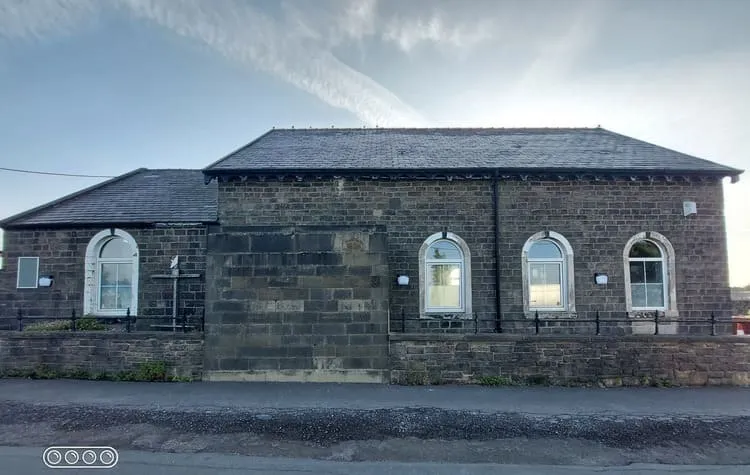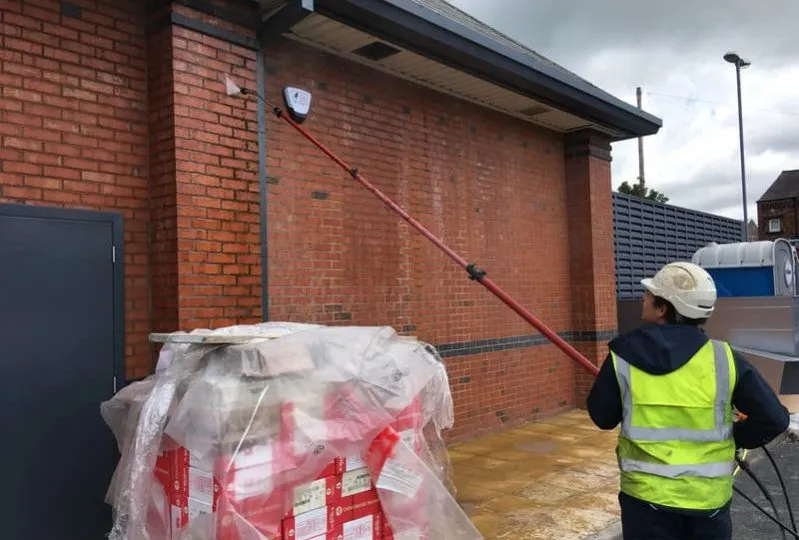- info@cleaning-service.uk.com
- SD Office, 491 Wight Moss Way, Southport PR8 4ZZ
5 Signs Your Brick Wall Needs Cleaning – And What to Do About It
If you’ve ever wondered why some Victorian terraces look pristine after 150 years whilst others appear ready for demolition, the answer often lies not in the original construction, but in how the bricks have been maintained – or neglected.
In this article, we will walk you through the five signs that your brick wall needs cleaning, as well as how to tackle each problem.

1. Moss, Algae, Lichen
That moss growing on your north-facing wall to some might look charming, but here’s the problem – moss roots are like tiny crowbars. They work their way into your mortar joints, and every time it rains (so, constantly in the UK), those roots swell. Come winter, the water in those roots freezes and expands.
We’ve seen 5mm gaps appear in mortar joints within two winters once moss takes hold. That’s enough to let driving rain straight through to your internal walls.
What actually works:
Forget the pressure washer (for now). Start with a biocide specifically designed for masonry – Algoclear Pro or similar.
- Apply it on a dry day when no rain is forecast for 48 hours.
- Wait. Seriously. Let it work for 2-3 weeks. The growth will turn brown and start to detach.
- Then use a soft brush or low-pressure rinse. The dead growth should come away easily.
For prevention, consider trimming back overhanging branches and improving drainage at the base of the wall.
The signs:
Moss concentrated along mortar lines
(it grows there first because mortar is more porous)
- Dark staining spreading outward from the moss
- Mortar that sounds hollow when tapped with a key
2. Efflorescence
Those white, crusty deposits are called Efflorescence. It occurs when water is moving through your brickwork, dissolving salts, and depositing them on the surface. Here’s what most people get wrong: they clean it off and think job done.
But if efflorescence keeps returning to the same spot, you’ve got water getting in somewhere. We’ve traced persistent efflorescence to everything from hairline cracks in render three metres away to faulty lead flashing on a chimney.
Critical difference:
- New build efflorescence: Appears everywhere, fades after 18 months
- Problem efflorescence: Returns to specific areas, gets worse in winter
The fix that works: First, find the water source:
- Around windows? Check the sealant and sills
- Low down? Could be splashback or rising damp
- Random patches? Look up – might be a leaky gutter
Only after fixing the water ingress should you clean. Use a dry brush first – most efflorescence comes off without any chemicals.
For stubborn deposits, use a brick acid cleaner diluted to manufacturer’s specs – but here’s the crucial bit: wet the wall first. Dry bricks will absorb the acid, causing more problems. Rinse thoroughly. Then rinse again. Acid residue causes more efflorescence.
3. Carbon Deposits and Traffic Film
Those dark streaks running down from windowsills are a combination of atmospheric pollution, rain runoff, and often the breakdown of sealants or paint from above. In cities, add diesel particulates to the mix. Near the coast? Salt spray accelerates the process.
London brick (the yellowish type) is especially vulnerable because its smooth face lets pollutants form a continuous film.
Why it matters:
This isn’t just cosmetic.
Traffic film is acidic (pH around 4.5).
Leave it long enough and it starts breaking down the brick face itself.
We’ve seen 1920s London brick walls where the face has eroded 3-4mm just from pollution.


Method that works:
Pressure washing just moves this stuff around. You need:
- A degreasing agent applied neat
- Leave for 20 minutes
- Water rinse at moderate pressure
- Second application if needed
Don’t believe anyone who says cold water pressure washing alone will shift proper traffic film. It won’t.
4. Mortar Joint Contamination
What you’re seeing: Dark lines along your mortar joints that won’t shift with normal cleaning. This is biological growth that’s penetrated into the mortar itself. Mortar is more porous than brick, so it’s often the first place problems show up.
Test: Scrape the mortar surface with a key. If dark staining goes deeper than 2mm, you’ve got penetration that surface cleaning won’t fix.
Professional secret: Poultice cleaning. Mix:
- Sepiolite powder (available from conservation suppliers)
- Biocide solution
- Water to form thick paste
Apply 10mm thick over stained joints, cover with cling film, leave 48 hours. The poultice draws contamination out from deep within the mortar. It’s messy and time-consuming but actually works, unlike repeated pressure washing which just drives contamination deeper.


5. When Cleaning Reveals Bigger Problems
Sometimes, what looks like heavy soiling is actually your brick face disintegrating. This is especially common with soft red bricks made before 1850. The first sign? Cleaning reveals a sandy, friable surface underneath.
The critical test: After cleaning a small area, press sticky tape firmly onto the brick and peel off. If brick dust comes away, stop immediately. You’re dealing with spalling brick that needs specialist treatment, not cleaning.
What to do:
- Document with photos (you may need these for insurance)
- Get three quotes from specialists
- Don’t use any sealers – they’ll accelerate the damage
If your brick wall has stood for 100+ years, it’s tougher than you think. The biggest risk isn’t the dirt – it’s aggressive cleaning. When in doubt, start gentle.
You can always go stronger, but you can’t undo damage from that angle grinder someone suggested for “quick results.”


Enquire about Brick Cleaning Service here
The Money Talk: When to DIY vs Call the Pros
DIY makes sense when:
- It’s surface dirt or light biological growth
- You can safely reach all areas
- The wall is in good structural condition
- You have time for multiple applications
Budget £150-300 for quality cleaning products, brushes, and safety gear for an average semi-detached house.
Professional cleaning makes sense when:
- Working above first-floor height
- Dealing with heritage bricks (pre-1920s)
- Multiple issues present
- You value your weekends
Expect £20-40 per square metre for professional cleaning, depending on method and access.
Your brick walls are probably the most expensive wearing surface on your property.
They’re designed to last centuries, but only with appropriate care. If you catch any of these issues early, means relatively simple, inexpensive fixes. Wait five years, and you’re looking at scaffolding, repointing, and whatnot.
At Cleaning Service Ltd, we specialise in professional brick cleaning across Cheshire, Lancashire and Manchester. We use advanced techniques and eco-friendly products to restore your brick walls to their former glory. Our team is equipped to handle both common and complex cleaning tasks with precision.
If you have any questions feel free to call us on 0800-0933-267 or if you prefer mail then write to us on info@cleaning-service[dot]uk[dot]com

Connect with Chris Spruce
Meet the Founder: Committed to delivering exceptional results for every property in North-West!
– 20+ years of experience in exterior cleaning.
– Personally involved in every cleaning project to ensure 100% satisfaction.
What our Customers say
EXCELLENTTrustindex verifies that the original source of the review is Google. Chris did an outstanding job on our very tired and neglected garden. In one morning he transformed the place. I can't thank you enough. Very good service, punctual and polite. Thank you Chris, see you again soon!Trustindex verifies that the original source of the review is Google. Chris Spruce did a brilliant job cleaning the render on our house and the roof on our rental. He turned up on time, worked hard all day and left everything tidy. The render had gone black but now it looks as good as the day it was done. Really impressed and would definitely recommend him!Trustindex verifies that the original source of the review is Google. Chris is such a professional, with a great attention to detail. Our old imprinted concrete driveway has been meticulously cleaned, recoloured and then new resin applied. It looks fabulous. We are so pleased and have had so many people admiring the driveway. If you want a job done well, we highly recommend Chris.Trustindex verifies that the original source of the review is Google. Exterior cleaning of render on my house . It came up beautifully some heavy smoke stains on chimney removed all stains gone . Looks excellent. I was advised how to care for render and also what to do to try and stop stains recurring in the future . Very useful advice received. A very knowledgeable and friendly team worked hard and cleaned up nicely after they finished. I would highly recommend Chris and his team.Trustindex verifies that the original source of the review is Google. Chris did an excellent job , the render looks like new. Really responsive and no fuss , kept in touch with me all through the process. 3 months on since I had the work done at it’s still looking really good. I will be using Chris again when I need any more work doing.Trustindex verifies that the original source of the review is Google. Chris is a lovely guy arrives on time does a fantastic job. Have used him a few times now and will continue to use him to maintain our house.Trustindex verifies that the original source of the review is Google. Fantastic job by Chris and his team as always. Well recommended.Trustindex verifies that the original source of the review is Google. Amazing job, exceeded expectations. All with the minimum of disruption. Very professionalTrustindex verifies that the original source of the review is Google. Excellent friendly service. Job done thoroughly and quickly. I would fully recommend this contractor.Trustindex verifies that the original source of the review is Google. Chris has done an amazing job cleaning our resin driveway, it looks like new again. Chris also took the time to clean up our sandstone steps which must have had decades of grime. Fantastic job and Chris is a really lovely chap, friendly and hardworking and has given great advice for future maintenance. I would highly recommend him for any cleaning jobs.Verified by TrustindexTrustindex verified badge is the Universal Symbol of Trust. Only the greatest companies can get the verified badge who has a review score above 4.5, based on customer reviews over the past 12 months. Read more
